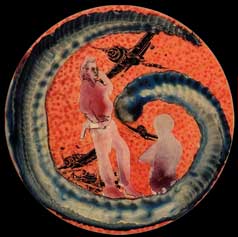There is, more than an echo, a network, a complicity. And it occurred to me that it’s no accident that Louise Bourgeois, Nancy Spero, Kiki Smith, and now Nalini Malani, the seminal figures of a renewed art of the last quarter of the 20th century, had their first solo shows in France in the rooms of the Galerie Lelong.
Jean Frémon
Art in America
October 2009 NO. 9
Nalini Malani
10/22/09
Lelong
By Paul B. Franklin
Paris In “Cassandra,” her first solo show in France, Nalini Malani has returned to her artistic roots: drawing and painting. “I draw therefore I am,” she has proclaimed. “Drawing/painting helps me to dream, to free associate, to flow into reveries.” Born in Karachi in 1946 on the eve of India’s independence and painful partition, Malani lives and works in Mumbai. Since the 1990s, she has garnered renown in both the East and the West for her intricate figurative work. Despite a successful foray into multimedium installations, Malani has never lost her appetite for traditional mark-making on two-dimensional supports. The 32 new paintings (all 2009) and 17 recent ones (2006-08) on view revealed the encyclopedic scope of her imagination, which is refreshingly unhampered by national boundaries.

Except for a few works on paper, all the pieces included in “Cassandra” were reverse paintings. Malani has perfected this ancient technique over the past decade, employing clear acrylic sheets instead of glass. Occasionally she applies pigment to both sides of the plastic before framing it behind a second panel. The effects of depth and relief are subtle and mesmerizing.
In constructing her epic visual narratives, Malani draws on
sources both classic and contemporary. Influences range from Indian literature, Hinduism and Greek tragedy to modern theater and poetry (Brecht, Beckett, Heiner Müller) and current events. She is well versed in feminist and postcolonial theory, but neither infiltrates her work in a didactic manner. Full of disparate floating images that resist coherent narrative, her surreal compositions suggest dreamscapes of the nightmarish tenor associated with Bosch. Disembodied organs (brains, kidneys, intestines), umbilical cords, mutating blobs, monsters, angels, turds, human figures and animals vie for attention. Faces abound. The majority of her new paintings are tondi, from roughly 10 to 60 inches in diameter. With titles like Warriors and Green Worm, Angel, and Mutants and Animals, many feature a gigantic larva-like creature that suggests the snail-like shape of the inner ear. Their spotted grounds, some an aqueous red (blood?), others blue (water?), call to mind cellular universes. Female archetypes like Sita, Medea, Alice in Wonderland, Radha and Mother Courage regularly populate Malani’s paintings. In the monumental Cassandra (2009), the show’s 30-panel centerpiece, the cursed prophetess levitates against a yellow ground amid a plethora of the artist’s trademark symbols. Rendered in black and gray washes, the hairless, virtually lifeless woman appears to have been burned alive. In style and content, this meditation on feminine resistance and trauma is akin to those of Kiki Smith and Nancy Spero. Confounding linear interpretations, Malani’s paintings are trenchantly evocative.
Photos: Nalini Malani: Warriors and Green Worm, 2009, acrylic, ink and enamel reverse painting on acrylic sheet, 173⁄4 inches in diameter; at Lelong. Cassandra, 2009, acrylic, ink and enamel reverse painting on acrylic sheet, 30 panels, 881⁄2 by 1531⁄2 inches overall; at Lelong.
DOWNLOAD Kunst Kompass 2009
DOWNLOAD TELERAMA SORTIR DU 20 AU 26 MAI 2009 No 3097